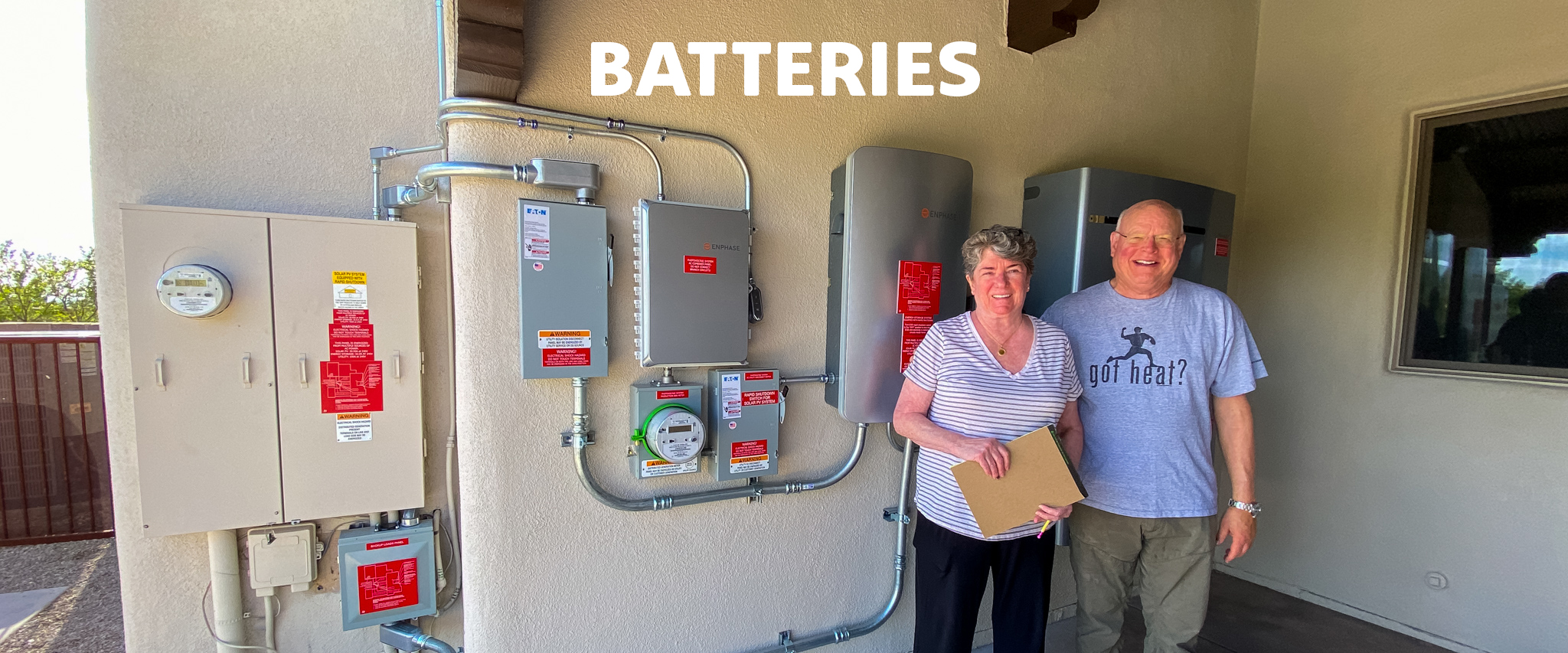
Are you interested in batteries for energy storage for your home? We’d love to share our knowledge about the main advantages of energy storage in southern Arizona, explain some product options, and walk you through the steps of design and installation. We’ll also dispel a few common misconceptions.
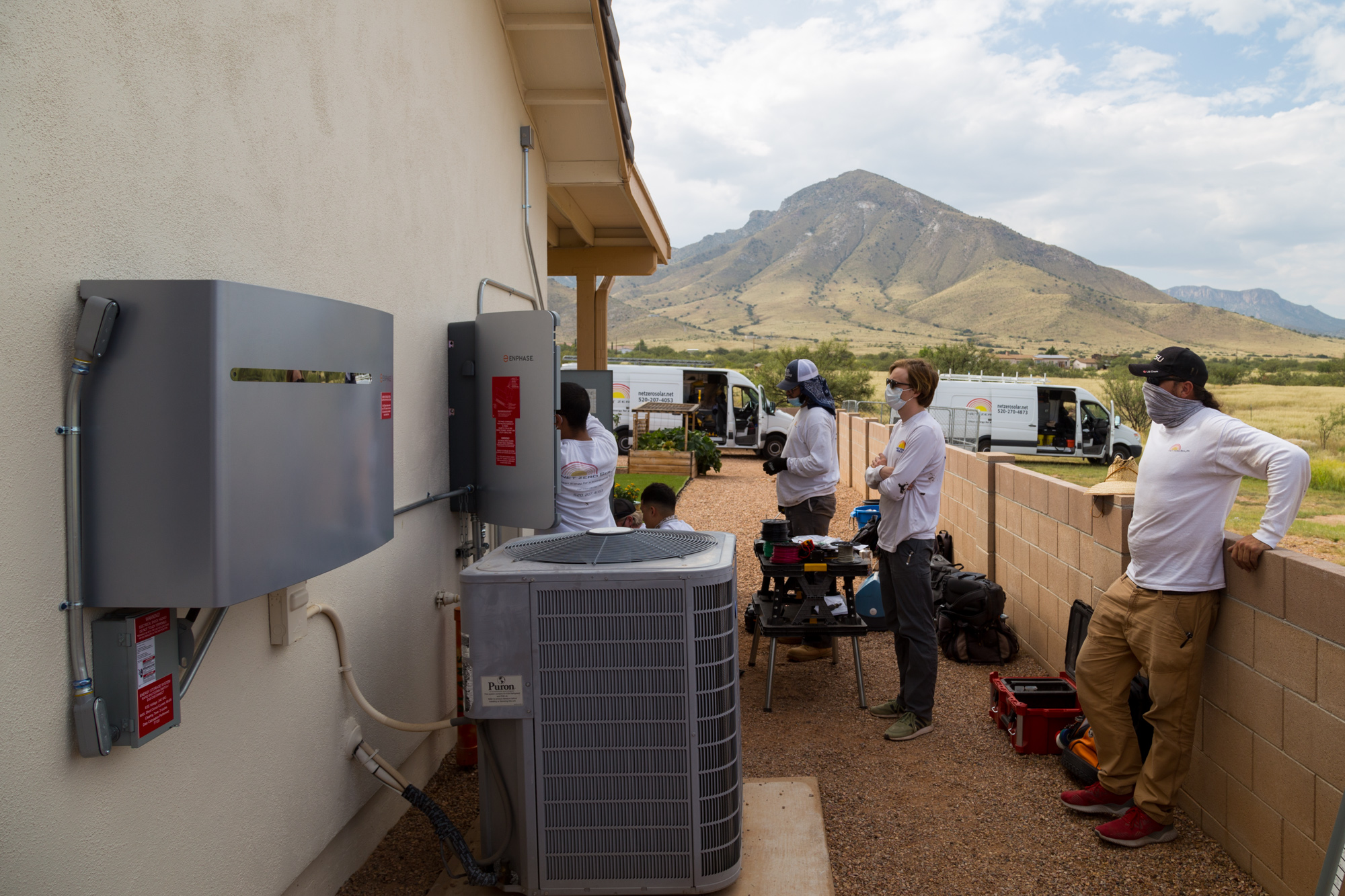
One of our crews installing a battery backup system in Hereford, Arizona
One of the most common uses for batteries in Tucson and Southern Arizona is for backup. These systems are set up to power a few electrical loads when the grid goes down, for a several hours if there’s no sun. With sunny days, many energy storage systems can run backed-up loads for several days or more.
Typically, customers choose important smaller loads, like their lights, computers, a refrigerator, and perhaps a window air conditioner or mini-split. Larger, more expensive systems can power more and larger loads for longer times.
Many backup systems are installed with solar electric systems that can charge the batteries during the day, even if the grid is not available.
We pair existing Enphase Energy solar electric systems with the Enphase IQ Battery energy storage system.
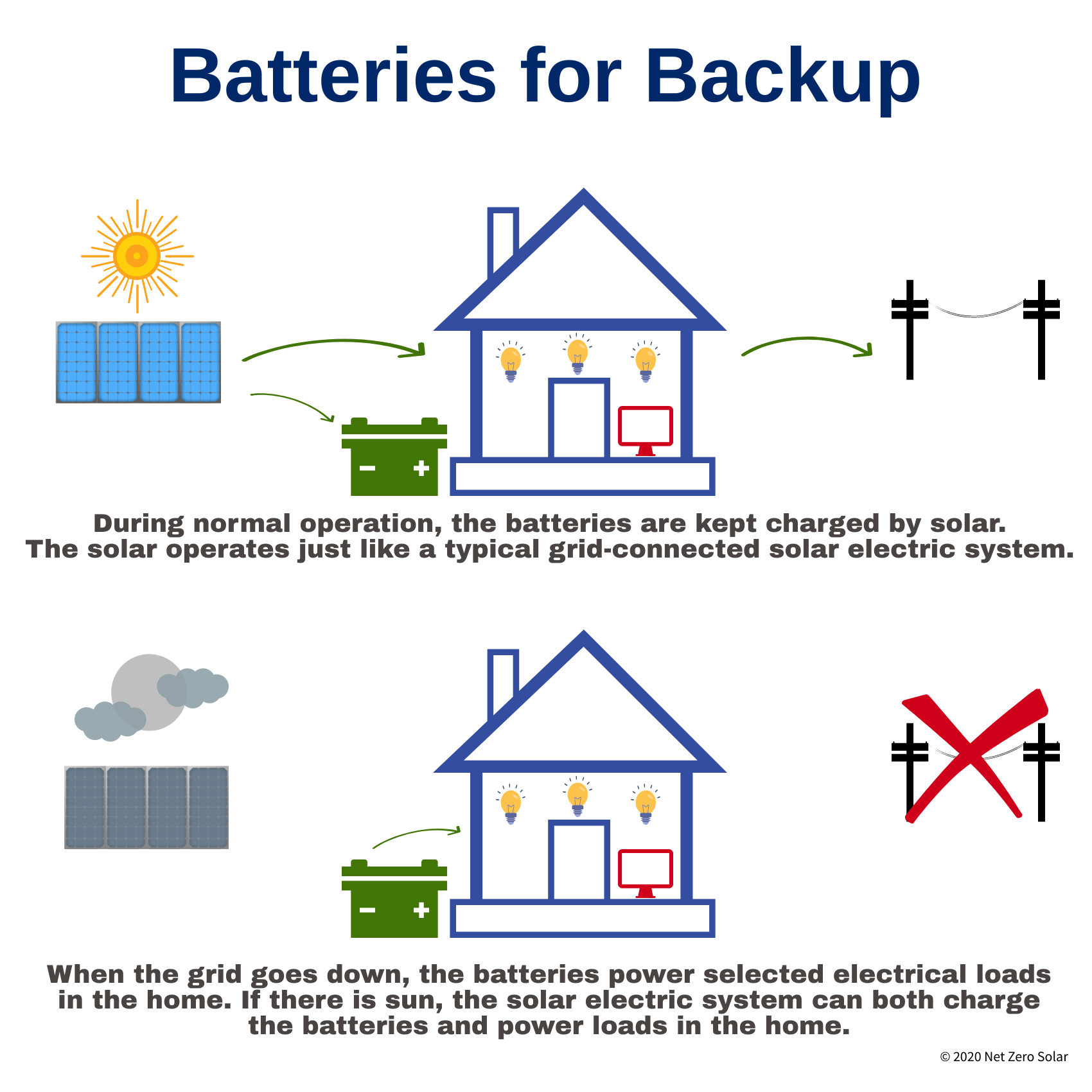
If you like to keep your energy as local as possible and use your clean solar energy at night, instead of buying dirty fossil fuel electricity, you may want to install storage batteries for independence. When your solar electric system produces energy during the day, it will first charge the batteries, before exporting any energy to the grid. At night, you can use the energy stored in the batteries to power some or your electrical loads, depending on the system size and design.
These systems can also be configured to send no electricity to the grid, if a utility does not allow energy exports.
Most systems can be configured to provide both backup and energy independence at the same time. However, a homeowner will have to choose the percentage of storage dedicated to each use. For example, you might choose to keep 50% of your battery capacity available for backup at all times, and use 50% of your battery capacity for energy independence on a daily basis.
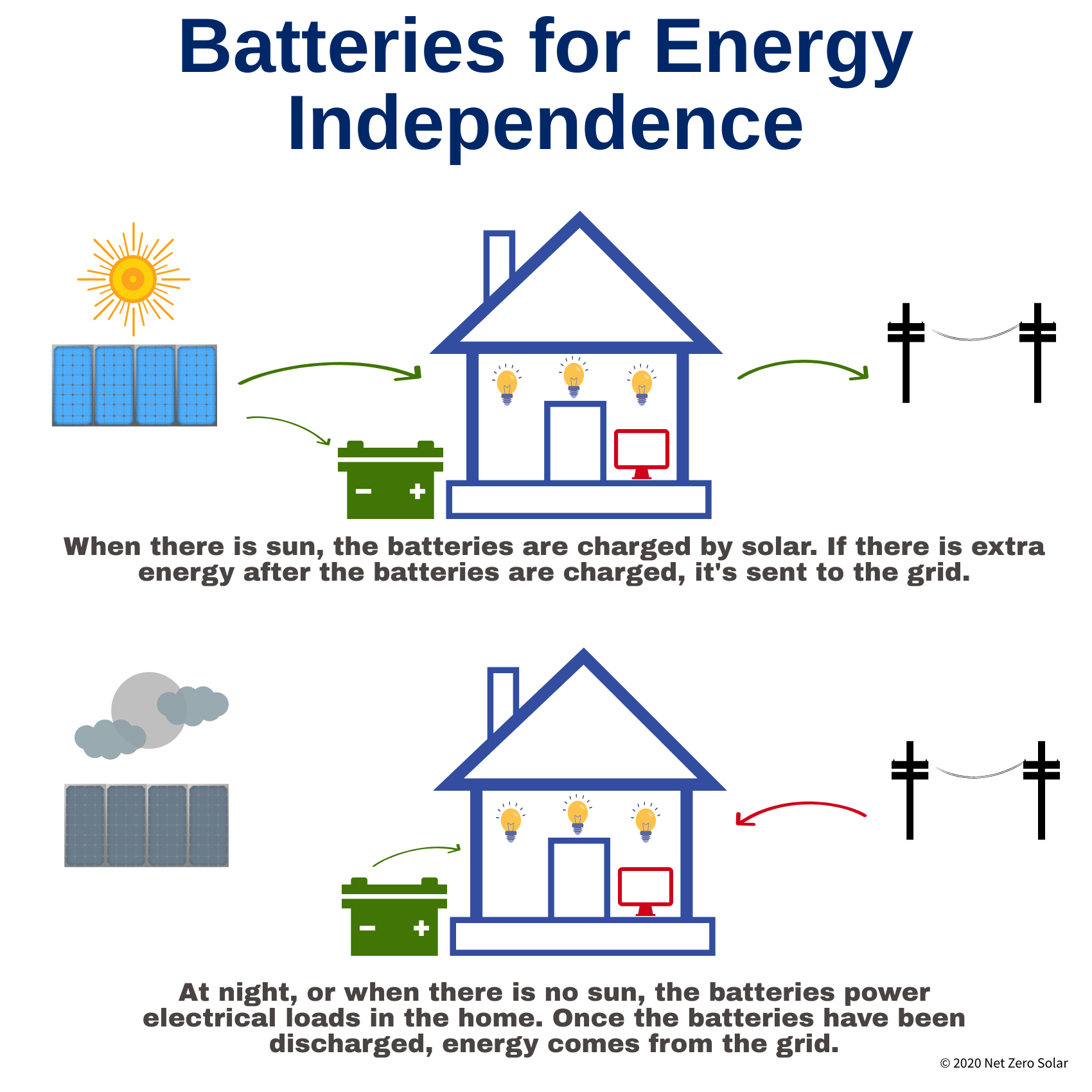
If you are able to store the energy you generate during the day in a battery, you can avoid buying power at night, or you can avoid exporting energy that’s only compensated for at a low rate, in addition to the value of having battery backup.
Depending on which southern Arizona utility serves your home, you will pay between 12-23¢/kWh for energy you purchase from the grid. For TEP, UNS Electric, and APS, you might pay different rates based on the time of day you use that energy, called a time-of-use rate. All these utilities also pay consumers for energy that’s sent back to the grid. Each utility’s “export rate” is different, but they range from about 3.6¢/kWh to about 7.6¢/kWh.
The maximum savings from storing energy on these rates is based on the difference between the highest rate you’d have to pay to buy power, and the amount the utility compensates you for energy you send to them.
Let’s take a look at a real example. Most solar customers in Tucson go on TEP’s TRREST rate. It’s a time-of-use rate. In summer, the difference between power prices during on-peak and off-peak periods is significant. In winter, the difference between on-peak and off-peak power prices is fairly small.
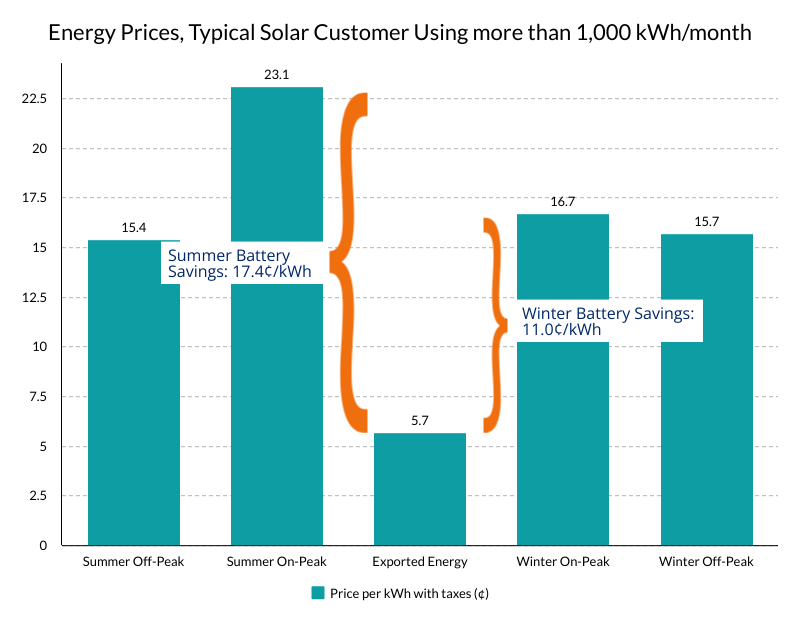
As the graph above shows, if we store extra solar energy in batteries during the middle of the day during the summer, we could use that energy during the peak hours of 3:00pm-7:00pm, and avoid buying energy at 23.31¢/kWh. If we simply sent that extra energy to TEP during the day, they would compensate us at 6.33¢/kWh. So the maximum possible savings from saving extra solar energy in batteries in the summer is 23.1¢/kWh minus 6.33¢/kWh, or 16.77¢/kWh. In winter, the maximum savings is $10.37¢/kWh. For year-round, this averages to 13.04¢/kWh.
But how much does it cost to send energy through batteries, when we consider the material and installation costs? At current prices, around 15-30¢/kWh. (See below for a calculator).
Because it costs more to send energy through the batteries than possible savings, you’d actually pay more if you buy batteries only to store the energy locally. But if you buy a battery primarily for backup purposes, you would be able to recoup some of the cost of that investment by using it to store energy each day.
For example, if you install a system with two Enphase Energy IQ Battery 5P batteries, they will have a total capacity of 10 kWh and a warranty of 15 years or 6,000 cycles. The net cost for installation after federal tax credits would be about $11,900. If you choose to completely charge the batteries from solar during off-peak hours during the day, and discharge them down to zero percent during peak hours every day, you’d save about 13.04¢/kWh x 10 kWh x 365 days x 15 years = $7,139 over the warranted lifetime of the battery. If the battery lasts beyond the warranty period, you’d save more.
The question then becomes, is the peace of mind that I can run some of my electrical loads when the grid goes down worth the net cost of the battery installation? In this example, the cost of backup is $11,900 less $7,139 saved from energy storage, or $4,761. Everyone’s budget is obviously different, but it might well be worth $26.45 per month for backup power when you need and want it.
Enphase IQ Batteries are an integrated energy production and storage system, designed to operate in either grid-connected or off-grid mode, and shift seamlessly from one to the other, as needed.
Many of the building blocks of the IQ Battery system might be familiar to you, especially if Net Zero Solar installed a system for you in the past. High efficiency solar modules are still connected to Enphase microinverters, which convert DC to AC.

A complete Enphase IQ Battery System (image courtesy Enphase Energy)
Where things get more exciting is the IQ batteries. This lithium iron phosphate battery stores energy. Inside, Enphase’s new IQ8 advanced microinverter is able to operate just like existing inverters when the grid is available.
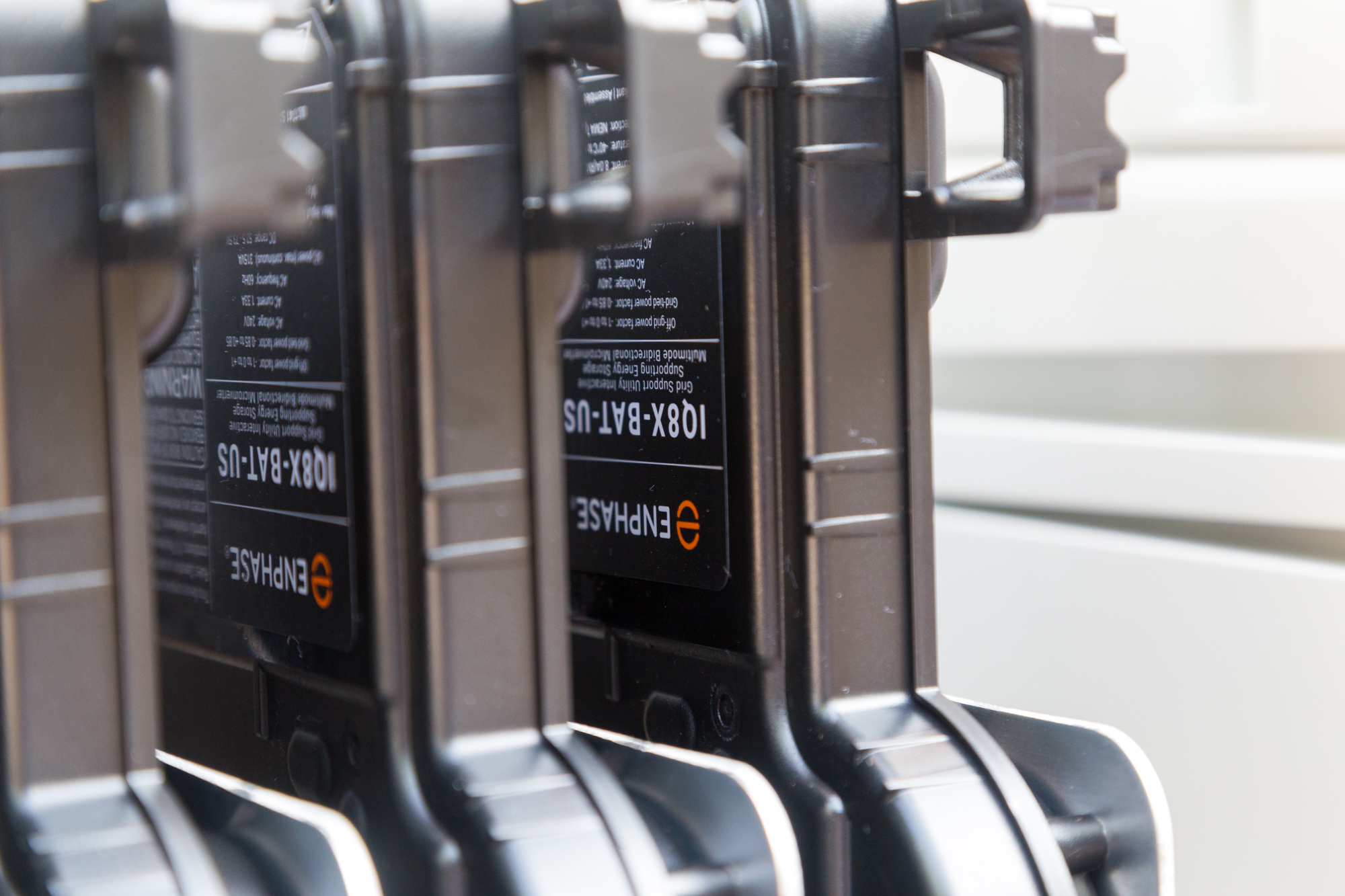
Enphase IQ8X Grid-Forming Microinverters Inside an IQ Battery
When the grid goes down, the IQ8s jump to “grid-forming” mode, sending power to the home’s loads as needed, and receiving power from the solar modules & microinverters to charge the batteries inside the unit.
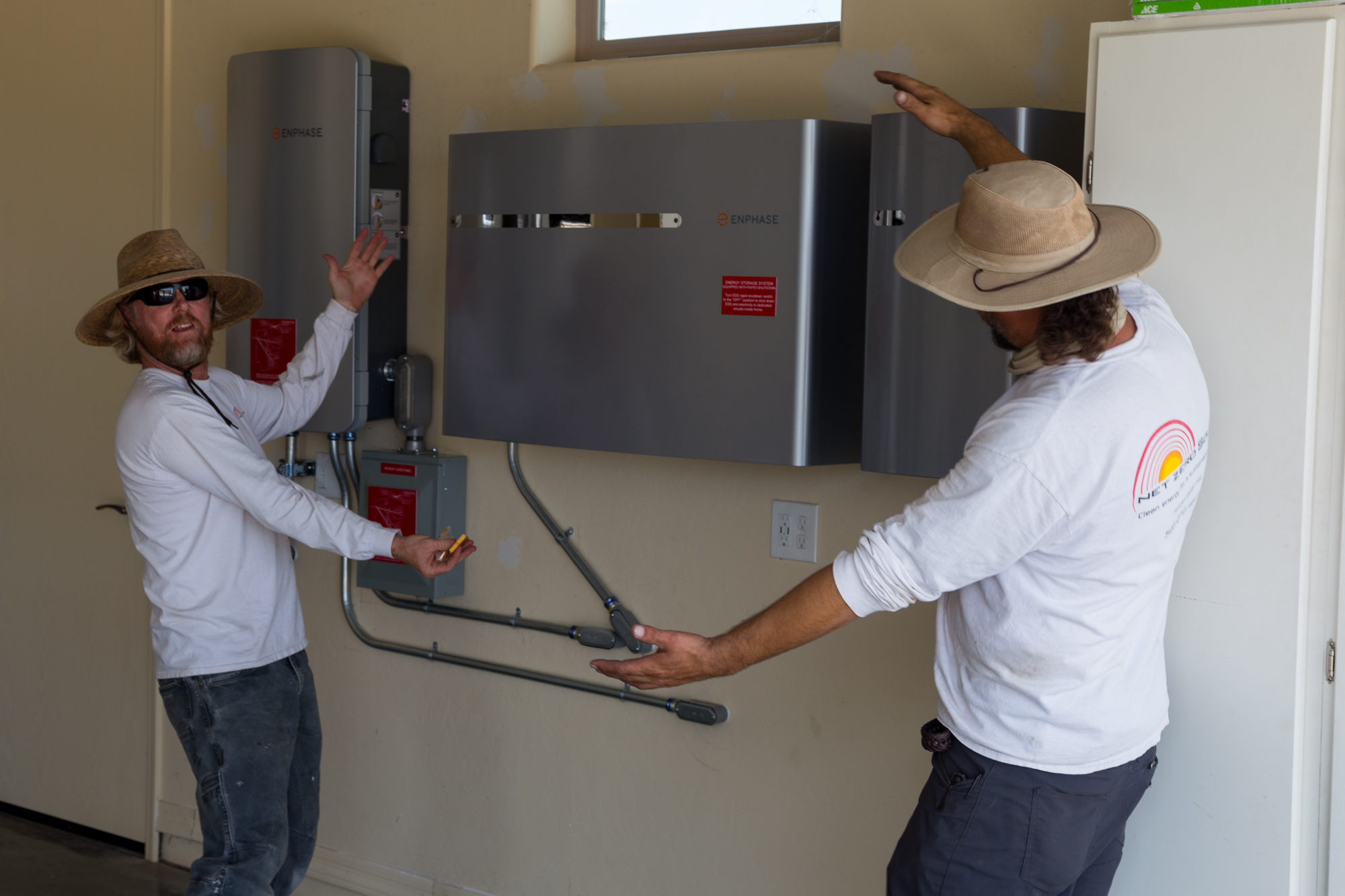 An IQ Battery 10 and IQ Battery 3 System Installed in Sierra Vista, Arizona
An IQ Battery 10 and IQ Battery 3 System Installed in Sierra Vista, Arizona
There’s one more critical component: the IQ System Controller, often called a microgrid interconnect device. The IQ System Controller acts as a “referee” between the microinverters and modules, the IQ Batteries, the loads in the home, and most importantly, the grid. When the grid goes down, it isolates the other components from the grid, so your home can become an independent “microgrid” until the grid returns.
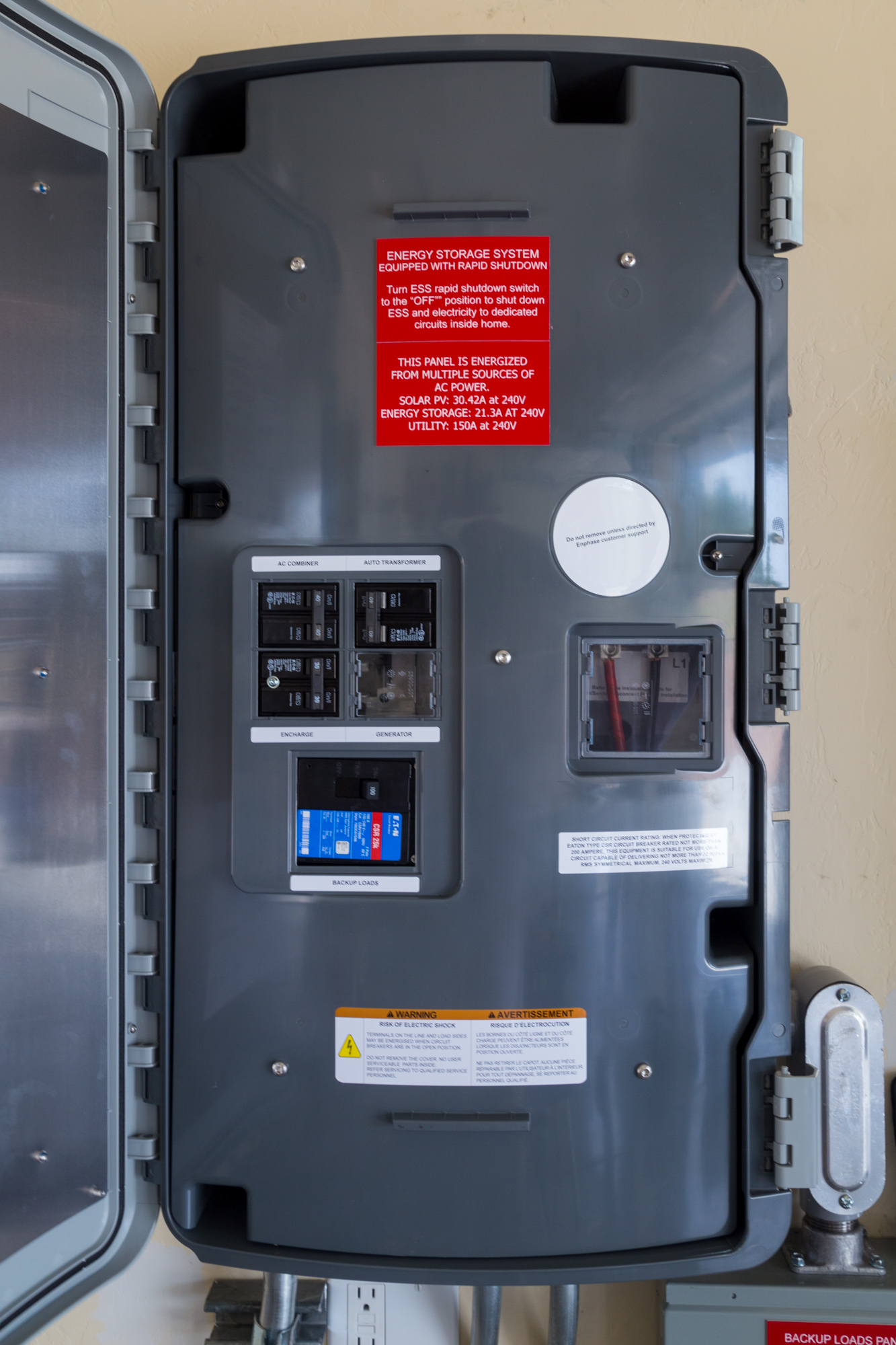 An IQ System Controller
An IQ System Controller
For existing clients, note that some older Enphase installations may require you to upgrade your existing microinverters. If your existing microinverters are IQ-series, you won’t need to have them upgraded. As always, we’re more than happy to discuss detailed options for your particular situation.
The sizing of these systems is based on what you’d like to be able to run when the grid is down, and for how long. We’ll share more details on sizing for any energy storage system below.
The first step in sizing and designing your energy storage system is to define your needs. What do you want your energy storage system to do? For most grid-connected systems focused on backup, we can break this into three typical options, each designed to power loads when the grid is down, and the sun isn’t shining:
1. Power a few lights, a refrigerator, a computer or TV, and a fan for 2-8 hours
2. Power lights, a refrigerator, electronics, and a window air conditioner or mini-split for 2-8 hours
3. Power the whole house, including air conditioners or furnaces for 2-8 hours.
Of these options, the first will be the most cost effective and simple. The second option is attainable for many homes. The third option is usually very expensive, and not as practical. In fact, if you want to power your whole home for long periods of time, a backup generator may be a better choice.
Once you’ve selected one of these general options, we can start to dig into the details. The first step is a load estimate. This is a list of all the electrical loads we want to use from our energy storage system, and how long we want to use them. From the load estimate, we can figure out the maximum power needed from the battery, in kW, and the energy needed over time, in kWh.
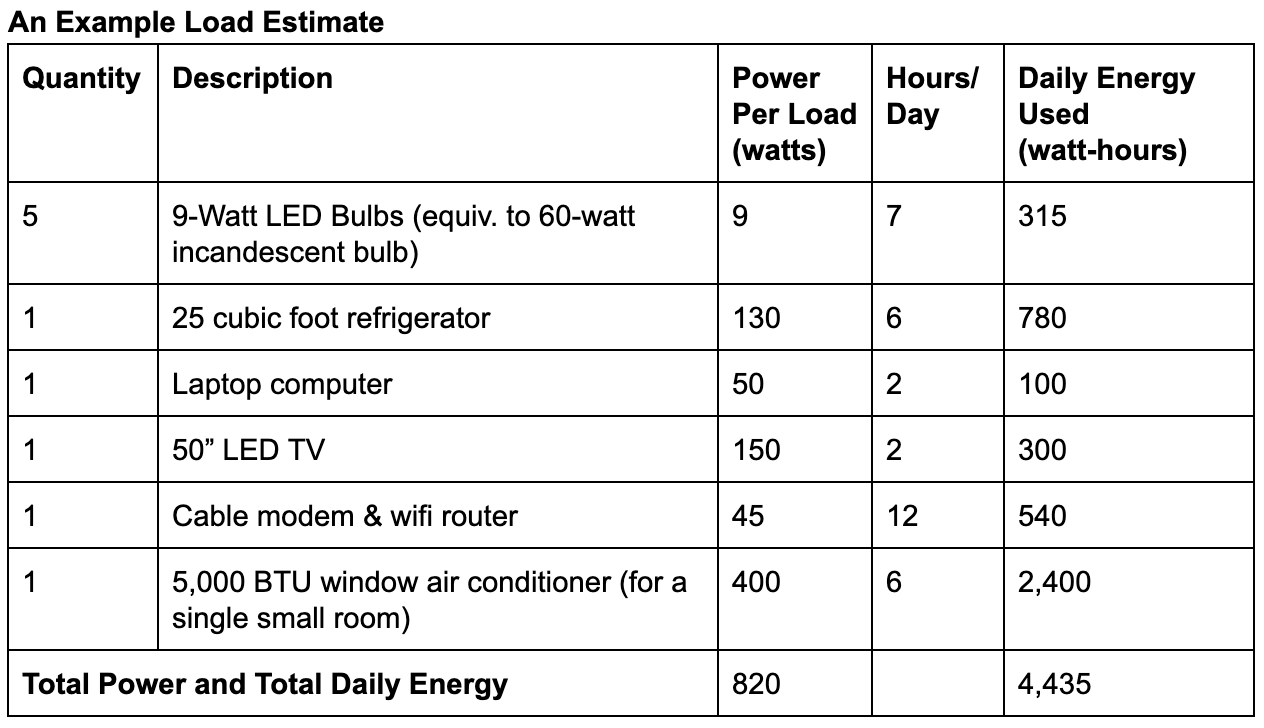
Energy storage systems provide both power and energy. You’ll need both to start your electrical loads and keep them running.
Power–measured in watts or kilowatts–is the instantaneous rate of electricity use. Small loads, like LED light bulbs don’t use much power, as you can see above. But big loads have big power requirements. For example, a home-size air conditioner could take over 7,000 watts of power!
Your energy storage system has to be able to provide enough power to run as many loads as you plan to turn on at the same time. If we use the example above, the system will need to be capable of providing 820 watts to keep everything going at once.
Energy is power over time, measured in watt-hours, or thousands of watt-hours, abbreviated kWh. For example, if we run a 9 watt lightbulb for 10 hours, it will have consumed 90 watt-hours, or 0.09 kWh.
Your energy storage system needs to be able to supply energy to meet your expectations as well. With the example above, the system would need to have 4,435 watt-hours available for each day & night you expected that the grid might be down, and the sun isn’t shining to recharge the battery.
One additional critical design aspect is making sure the energy storage system will supply enough electrical current to start up any motors or similar electrical loads. These loads may take 3-6 times their running power for a few seconds while they are starting up–what we call “starting surge power.”
So what storage system might you choose for backup to meet the needs from the load estimate above? If we look at the Enphase IQ Batteries, an Enphase IQ Battery 5P has a rated output power of 3,840 watts (3.84 kW), and a total usable energy capacity of 5,000 watt-hours (5.0 kWh). The power rating is much higher than the 860 watts we might need. The energy capacity is just a bit higher than the estimated daily energy. As long as only these loads are used, and they are used for only the number of hours shown above, a single IQ Battery 5P can meet the needs of our example load estimate.
If loads are added, or if loads are run longer than expected, the battery will probably not have enough power or energy capacity. For example, if a 5-ton central air conditioner was added, the needed power just for that one appliance could be 4,470 watts, more than the IQ Battery 5P can output.
Another example would be to run the single window air conditioner shown above for twelve hours overnight, instead of for six hours. Because of the additional 2,400 watt-hours needed for the extra six hours of runtime, a single IQ Battery 5P would be discharged before twelve hours had passed, going offline once its capacity of 5,000 watt-hours was used.
Next, let’s look at a surge power example: A 2-horsepower submersible well pump might take around 2,400 watts while running, but could take up to 14,400 watts for a few seconds while starting. Although a single IQ Battery 5P can output 7,680 watts for up to three seconds, it would probably not be able to start this pump. To run this pump, an electronic device to reduce surge current would need to be added to the well pump, or a bigger energy storage system with more batteries would need to be installed.
If you’d like to build your own load estimate for your needs, please see our calculator below.
While these examples may seem complex, it’s critical to carefully think through what your needs, desires, and budget is, so we can work together to design a system that you’ll be happy with for years to come. Now you’ve started on the first part of your path to energy storage, please get in touch with us to further define your needs, and move to the next steps in the process.

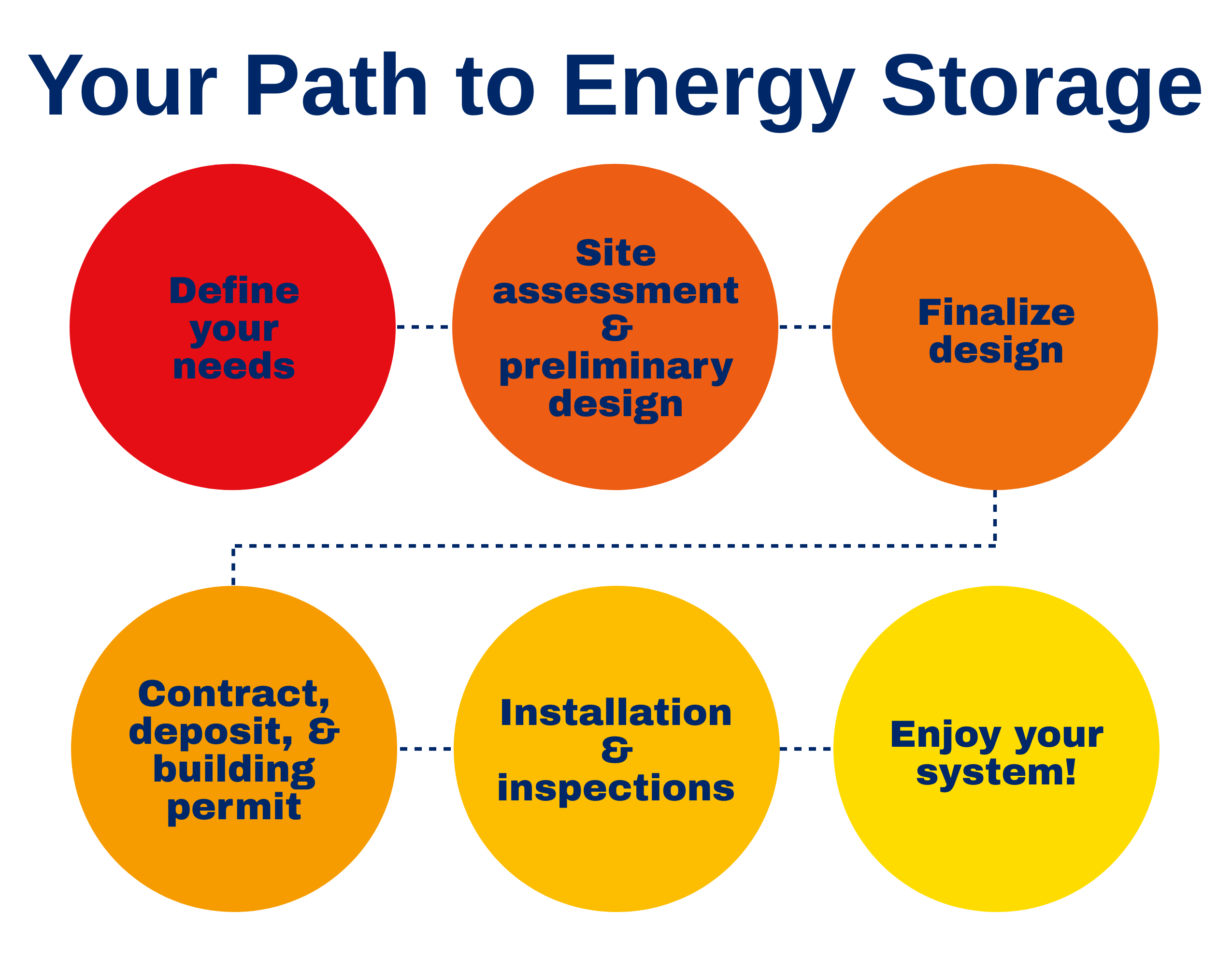
We sometimes ask, is the glass half full, or is it half empty? State of charge and depth of discharge have a similar relationship. State of charge is how “full” the battery is, between 0-100%. Depth of discharge is how “empty” the battery is, also in percentage.
For example, a completely charged battery will have a SOC of 100%, and a DOD of 0%. A battery with an 80% DOD? That’s a SOC of 20%.
Why should you care about SOC and DOD? First, if you have energy storage installed, you’ll have a monitoring system that will show you how full the batteries are in SOC, so you’ll know how much energy you have available. Second, battery manufacturers will rate or warranty their products for a certain number of cycles, at a certain depth of discharge. This information allows you to calculate how much energy you can send through your battery bank, before it needs to be replaced.
What’s the best way to understand the cost of batteries over time? We can calculate the lifetime cost per kWh. Put simply, this is the total cost of the battery system, divided by the total amount of energy we take out of the batteries over that time.
You can see an example above in “The Value of Energy Storage.”
We can use calculations like this to understand the best economic choices with a battery system. We believe that there can be many good reasons to choose energy storage beyond cost, especially if you value the security of powering electrical loads in short or long power outages. We also believe that consumers should thoroughly understand what energy storage can and can’t do. Try these calculations yourself, using our simple calculator.
--
